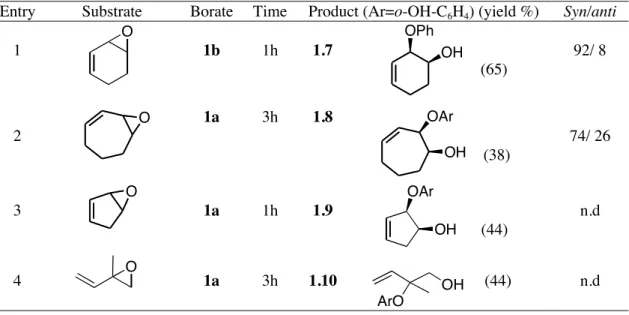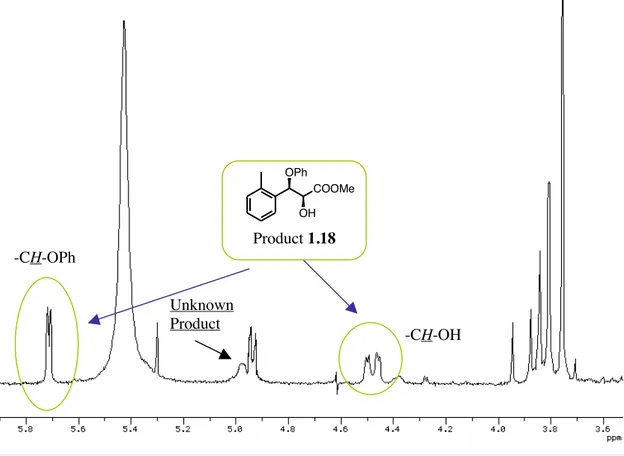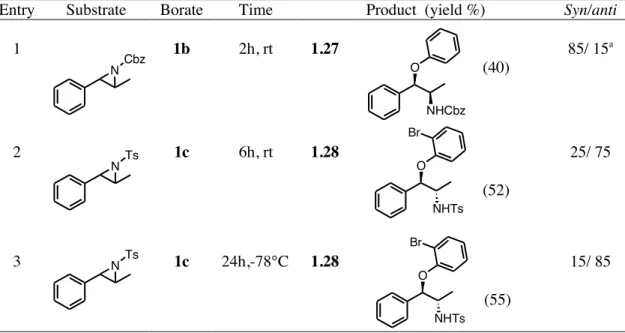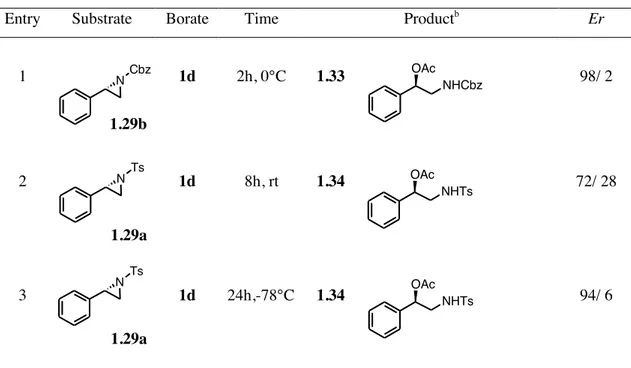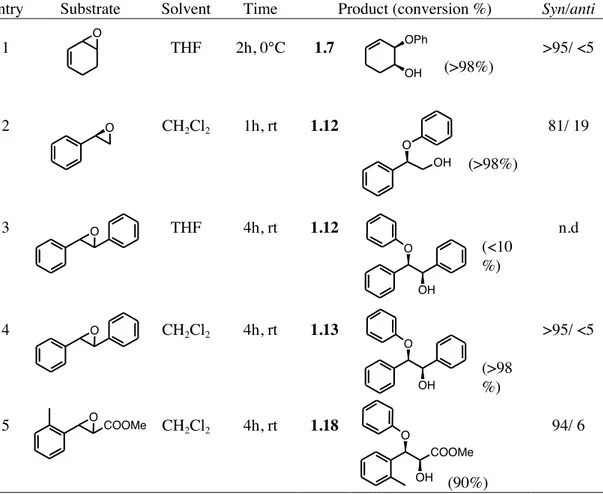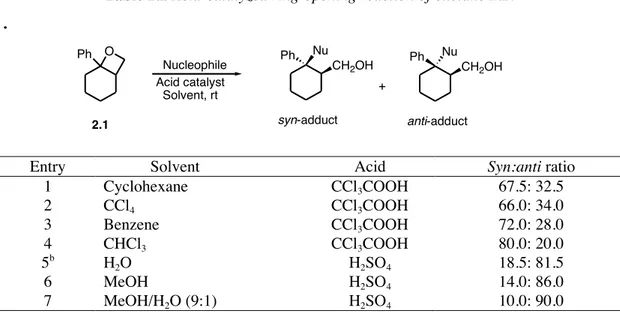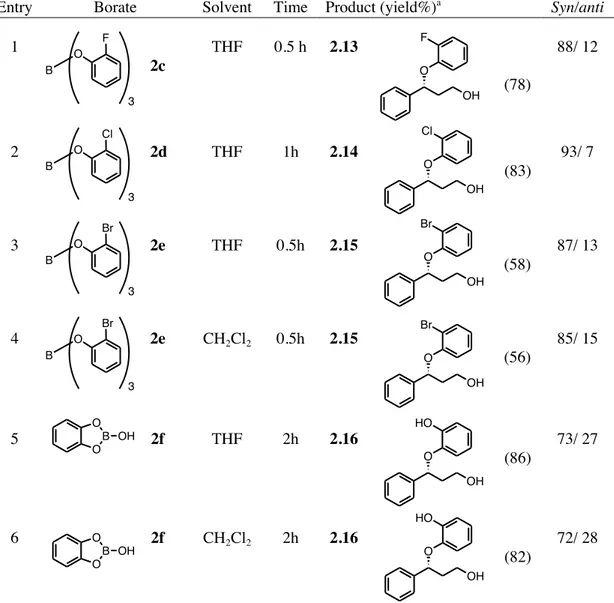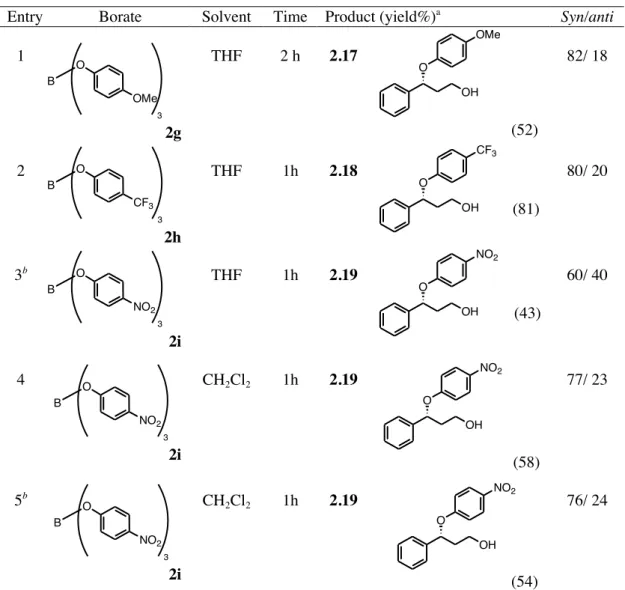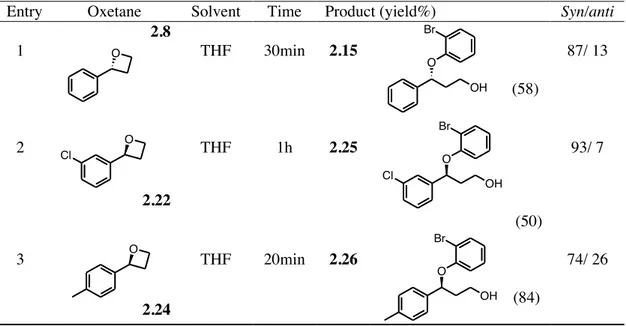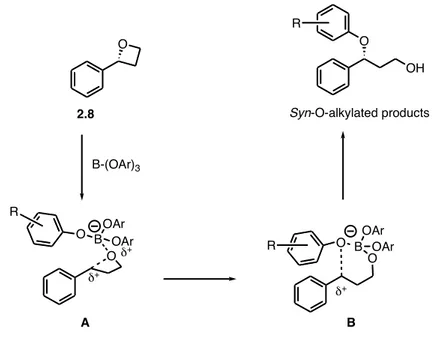UNIVERSITY OF PISA
School of Graduate Studies
“Scienza del Farmaco e delle Sostanze Bioattive
”
PhD THESIS
2005-2007
“New Strategies in Regio- and Stereoselective
Synthesis by the use of Small-Medium Ring
Heterocycles”
Ferruccio Bertolini
SUPERVISOR: DIRECTOR OF THE SCHOOL
Prof. Mauro Pineschi Prof. Claudia Martini
Index
Chapter 1
Stereoselective ring-opening of three-membered heterocycles with phenols
1.1. Intruduction……… 3
1.1.1.Ring-opening of three membered heterocycles with oxygen-nucleophiles… 3 1.1.2. Aryl borates………. 10
1.2. Result and discussion……… 13
1.2.1. Ring-opening of epoxides with aryl borates……….. 13
1.2.2. Ring-opening of aziridines with organo borates………... 21
1.2.3. Synthetic application of the ring-opened products: Synthesis of 1,4-benzodioxanes and 1.4-benzoxazines……… 28
1.2.4. Ring-opening of epoxides using other metal-based nucleophilic systems… 31 1.3. Experimental Section………... 34
1.4. Bibliography……….. 56
Chapter 2
Stereoselective ring opening of oxetanes with phenols 2.1. Intruduction……… 582.2. Result and discussion……… 62
2.3. Experimental Section………... 77
2.4. Bibliography……….. 91
Chapter 3
Intermolecular Friedel-Crafts alkylation of phenolic substrates with aryl and vinyl epoxides 3.1. Intruduction……… 923.1.1. Friedel-Crafts Alkylation………... 92
3.1.2. Intramolecular alkylation of aromatic systems with epoxides... 93
3.1.3. Intermolecular alkylation of aromatic systems with epoxides... 97
3.2. Result and discussion……… 102
3.2.1. Ring-opening of aryl and vinyl epoxides with electron-rich borates... 102
3.2.2. Synthetic application of the ring-opened products: Synthesis of 2,3-dihydrobenzofurans………... 117
3.3. Experimental Section………... 122
Chapter 4
Stereoselective carbon-carbon coupling of phenol derivatives with aryl aziridines
4.1. Intruduction……… 154
4.2. Result and discussion………. 158
4.3. Experimental Section……….… 169
4.4. Bibliography………... 186
Chapter 5
Metal-catalyzed desymmetrization of bicyclic hydrazines with sp2 carbon nucleophiles. 5.1. Intruduction……… 1875.1.1. 2,3-diazabicyclic systems……… 187
5.1.2. Asymmetric arylation of activated alkenes with boronic acid derivatives… 193 5.2. Result and discussion………. 198
5.2.1. Rhodium-catalyzed desymmetrization of 2,3-diazabicyclo[2,2,1]hept-5-ene derivatives with aryl boronic acids………... 198
5.2.2. Rhodium-catalyzed desymmetrization of 2,3-diazabicyclo[2,2,1]hept-5-ene derivatives with alkenyl boronic acids……….. 213
5.2.3. Rhodium-catalyzed desymmetrization of 2,3-diazabicyclo[2,2,1]hept-5-ene derivatives with alkynyl boronic acids……….. 218
5.3. Experimental Section……….… 221
Chapter 1
Stereoselective alcoholysis of three-membered heterocycles with phenols
1.1 Introduction
1.1.1 Ring opening of three-membered heterocycles with oxygen nucleophiles
Epoxides and aziridines are widely utilized as versatile synthetic intermediates and are considered as “spring-loaded” rings for the nucleophilic ring-opening.1 Their reactions are
dominated by the electrophilic nature of these heterocycles, generally involve the clevage of the strained three membered ring, and include a wide range of nucleophilic ring-openings to give ß-substituted alcohols and amine. In particular the ring-opening reaction of epoxides using O-nucleophiles (alcoholysis) represents a valid synthetic tool for the synthesis of ß-hydroxyethers, valuable intermediates in a variety of pharmaceuticals.2 In this field a
interesting example, reported by Mioskowski and co-workers, is given by the synthesis of
(-)-Muricatacin, an acetogenin isolated from a worldwide family of tropical plants called
Annonaceae having activity as antitumoral agent, where a ring opening reaction of a vinyl epoxide represents the key step.3 (Scheme 1.1).
Scheme 1.1 Synthesis of (-)-Muricatacin via stereoselective ring-opening with O-nucleophiles
In general, the reaction of three-membered heterocycles such as epoxides and aziridines with alcohols is quite difficult mainly because oxygen nucleophiles behave as poor nucleophilic reagents in substitution processes.4 Nevertheless, the use of strongly basic or acid
conditions or metal-catalyzed reactions are well-estabilished methods to obtain the corresponding ring-opening processes, which usually occurs in an anti-stereoselective way. With regard to the use of phenols in the ring opening reaction of oxiranic systems, in the last few years several methodologies, both non-catalytic and catalytic processes, have been developed. O C12H25 COOEt ring opening HO OR C12H25 COOEt O C12H25 OH O (-)-Muricatacin
In the field of non-catalytic approches to this kind of substitution processes, a very interesting work has been reported by Rama Rao and co-workers.2 Here the authors took
advantage of the use of cyclodextrins and their ability to catalyze chemical reactions with high selectivity. Cyclodextrins (CD) are cyclic oligosaccharides possessing hydrophobic cavities which, binding substrates through the reversible formation of host-guest complexes as a noncovalent bonding as seen in enzymes, are able to promote chemical transformations such as the ring opening reaction of epoxides. In this work the typical reaction was carried out in water by the in situ formation of the CD complex of epoxide followed by the addition phenoxide at 60°C to give the corresponding ß-hydroxy ethers with very good yields and high
anti-stereoselectivity (Scheme 1.2).
Scheme 1.2 Cylodextrins-Promoted ring opening reations of oxiranes with phenoxides.
It should be noted the high regioselectivity of this ring opening reaction: using also styrene oxide as starting epoxide the attack of the nucleophilic moiety occurs exclusively at the less hindered position notwithstanding the marked electrophilic character of the benzylic position of the epoxide.
In the last decade also several catalytic approches for the ring-opening reaction of epoxides with phenols have been described. In this field impressive results have been achieved by Jacobsen and Ready by the use of the well-known metal-salen complexes.5
Considering the extraordinary ability of this kind of catalysts in the hydrolytic kinetic resolution of terminal epoxides,6 the authors tried several combinations of metals and chiral
ligands finding in the use of (t-Bu-salen)Co(OC(CF3)3 (1.3) the best compromise for the
kinetic resolution of terminal epoxides of type 1.4 via enantioselective ring-opening with phenols (table 1.1). R O 1.1 ß-CD / H2O ArONa / 60°C
R = Aryloxy, aryl, hexyl
Ar = C6H5, p-Cl-C6H4, p-OMe-C6H4
R OAr
OH
Table 1.1. Kinetic resolution of terminal epoxides with Phenol.
Entry R Equiv. 1.3 Temp (°C) Yield (%)a Ee (%)
1 (CH2)3CH3 (1.4a) 0.044 25 97 98 2 CH2Cl (1.4b) 0.044 -15 97 99 3 CH2O(allyl) (1.4c) 0.044 4 93 97 4 c-C6H11 (1.4d) 0.088 -15 99 97 5 C(O)CH2CH3 (1.4e) 0.088 -20 96 96 6 CO2CH3 (1.4f) 0.044 -20 98 96 7 C6H5 (1.4g) 0.044 -25 n.d n.d
aIsolated yield based on phenol.
Looking at the table two things should be considered: the high enantioselectivity of this process also the use of a very low amount of catalyst further proving the efficiency of these catalytic complexes in the asymmetric ring opening reaction of epoxides. However, when the terminal epoxide was styrene oxide, the reaction resulted in a mixture of the regioisomeric ring-opened products. This is due to the competition for the attack of the O-nucleophile between the less hindered position of the oxiranic system, the usual site of this alkylation, and the electrophilic benzylic position.
In the complementary field of the enantioselective desymmetrization of meso-epoxides with phenols, a significant result was described some years later by Shibasaki and co-workers.7 Several symmetrical epoxides such as cyclopentene and cyclohexene oxides reacted
in toluene with p-methoxyphenol in the presence of gallium based chiral ligands to give the corresponding hydroxy phenols in interesting yields and, in some cases, very high enantiomeric excess (Scheme 1.3).
N N O O t-Bu t-Bu t-Bu t-Bu M M= Co(OC(CF3)3 (R,R)-1.3 OH + R O (R,R)-1.3 MS 3A / TBME O R OH 1.4 (2.20 equiv) (1.00 equiv)
Scheme 1.3 Enatioselective ring-opening of meso epoxides with p-methoxyphenol.
With regard to the mechanism the authors assumed that gallium metal center would act as Lewis acid and activate epoxides (I), while at the same time, the lithium binaphthoxide moiety would function as Brönsted base to activate the phenol (II) as summarized in Scheme 1.4. Activated nucleophile would then react with epoxide to give (III). Proton exchange between gallium alkoxide and the aromatic hydroxyproton coming from the phenol leaded to the epoxide opening adduct and regeneration of catalyst.
Scheme 1.3 Working model for the ring-opening of cyclohexene oxide with phenols catalyzed by heterobimetallic complexes
However, despite this significant results, it should be noted that the analyzed reaction gives high level of enantioselectivitiy only using an important amount (20 mol%) of this very
O R R + HO OCH3 (R)- GalB (20 mol%) Toluene, MS 4A R R OH OAr O O O O Ga Li R1 R1 R1 R1 R1 = SiEt3 (R)- GalB ee up to 96% O O O O Ga Li (R)- GalB O O O O O Ga Li O (I) O O O O Ga O ArOH Li OAr H (Ii) * * * * * * O O O O Ga Li H * * O OAr (III) OH OAr
complex gallium-based catalytic system, thus revealing the limitated efficiency of the described synthetic process.
It should be noted that the ring opening of small ring hetocycles with poorly nucleophile o-benzenediol (cathecol) represents an almost unexplored area. In literature nowdays there is only a representative example of this particular transformation which, by the use of very harsh basic conditions (NaH, EtOH, cathecol, reflux), permits the obtainement of the corresponding hydroxy phenols with fair to good yields and with high a n t i -stereoselectivity.8 (Scheme 1.5).
Scheme 1.5 Ring-opening reaction of epoxides with cathecol in basic conditions.
Vinyl epoxides are commonly used starting materials in organic synthesis. Despite they are only moderately active alkylating agents under classical displacement reactions, they are extremely reactive in the presence of some transition metal catalysts.9 There are few reports
regarding the ring opening of vinyl epoxides with oxygen nucleophiles. In this field, Lautens reported a mild rhodium-catalyzed reaction of vinyl epoxides with alcohols and amines, which occurs at room temperature with excellent anti-stereo- and 1,2-regioselectivity.10 In this
work the reactivities of several alcohol nucleophiles were examinated. Considering the model reaction carried out using cyclohexene monoepoxide, it could be observed the high efficency of this reaction condition with both primary and secondary alcohols while phenol gave the corresponding ring-opened products with a lower yield (Table 1.2).
Table 1.2. Rh-catalyzed reaction of various alcohols with cyclohexene monoepoxide.
Starting material Product Yield (R)
94% (Me) 92% (Et) 94% (iPr) 55% (Ph) R R 1 O OH OH NaH EtOH / reflux R R1 O OH HO R = R1 = aryl, alkyl + O OR OH
Regarding the reaction mechanism, there are two possible roles that rhodium might be playing: it could act as lewis acid, or it could insert into the carbon-oxygen bond to produce a π-allyl rhodium intermediate. However, since cyclohexene and styrene oxide didn’t react in these conditions, it can be observed that the presence of an olefin was required for the reaction, thus indicating that the rhodium was likely not acting as a Lewis acid.
One of the very few examples of the asymmetric ring opening of vinyl epoxides with alcohols was reported by Trost in 1998.11 Butadiene and isoprene monoepoxide reacted at
room temperature with several alcohols in the presence of catalytic amount of Pd(dba)3⋅CHCl3, the chiral ligand 1.5 and triethylborane to give the corresponding
ring-opened products in high enantioselectivity (Scheme 1.6).
Scheme 1.6 Boron-Palladium co-catalyzed asymmetric addition of alcohols to vinyl epoxides.
Even if the treatment of isoprene monoepoxide with trimethyl borate in the presence of the described palladium catalyst and ligand 1.5 gave the corresponding ring-opened product in good yield (80%), the presence of a catalytic amount of borane was crucial for the high enantioselectivity of the reaction. It also should be considered that indipendent experiments shown that trialkylborates didn’t react with this kind of epoxides in the absence of a palladium catalyst.
The last topic of this introduction concerns the behaviour of aziridines in the reaction with O-nucleophiles. While the ring-opening of N-sustituited aziridines with several nucleophiles such as amines12 and azides13 has been well studied in the last few years, the use
O-nucleophiles in this kind of process remains quite limited. Recently, Singh and co-workers reported a Lewis acid-induced ring-opening reaction of several N-Ts substituited aziridines with alcohols, which occurs at room temperature to give the corresponding N-protected amines in high yields14 (Scheme 1.7).
NH HN Ar Ar O O Ar= Ph2P O R + R1OH 1.5 Pd(dba)3 CHCl3 (1.0 mol%) 1.5 (3.0 mol%), (C2H5)B (1.0 mol%) THF, r.t OR1 R OH ee up to 98% R= H, CH3 10 equiv.
Scheme 1.7 Lewis acid-induced ring opening of N-tosyl aziridines with alcohols.
Despite the good results obtained using alcohols, it should be noted that phenols could only cleave aziridines under microwave irradiation and however the desired ring-opened products were obtained with considerably lower yields.
Very recently, Ghorai and co-workers reported an acid-catalyzed ring-opening of optically active 2-aryl-N-tosylaziridines with alcohols.15 In particular, the use of a
stoichiometric amount of Cu(OTf)2 in the ring-opening of this class of aziridines with
O-nucleophiles allows the obtainment of the corrisponding alcohoxy amines with very good yields, complete regioselectivity at benzylic position and very high anti-steteoselectivity (Scheme 1.8).
Scheme 1.8 Cu(OTf)2-Promoted ring opening of N-tosyl aziridine of styrene with alcohols.
However, it should be noted that this reaction proved to be effective only using primary alcohols while the use of phenols in this reaction conditions was not described.
To sum up, it can be observed that a truly pratical, general and highly regio- and stereoselective method for the ring-opening of three membered heterocycles with phenols has not been discovered so far. For this reason we tought to explore the possibility to develop a new stereoselective ring-opening of epoxides and aziridines with phenols and we found that triarylborates represent very useful reagents in this particular synthetic transformation.
NTs + ROH Lewis acid (10 mol%), rt
NHTs OR yields up to 98% NHTs Cu(OTf)2 1.0 equiv. NHTs OR R-OH yields= 76- 90% er up to 96/4 R= Me, Et, Allyl, Propargyl
1.1.2 Arylborates
Aryl borates, otherwise called triaryloxyboranes, are simple and easily-available compounds and they can be prepared by several methodologies using a “boron source” and the corresponding phenol (scheme 1.9).
Scheme 1.9 Possible approaches to arylborates.
This class of compounds has been studied since the fifties when, in the field of research on “boron polimer”, several synthesis of aryl borates were carried out using phenols such as cathecol, phenol and resorcinol in association with boron trichloride.16
Nowadays arylborates represent a versataile kind of organic reagents and they are used in several manner in a variety of synthetic transformations. First of all they can be used as catalysts and, in this field, an interesting examples was given by the use of triphenyl borate in the asymmetric synthesis of (-)-chloramphenicol.17 This catalyst, obtained after the reaction of
triphenyl borate with chiral diols such as (-) Binol, (-) Vapol, (-) Vanol, etc, allowed the formation of the aziridine described in the Scheme 1.10 by a catalytic asymmetric aziridination using the benzhydryl imine of p-nitrobenzaldehyde and ethyl diazoacetate. It
B O O O R R R BCl3 OH R substituition reaction OH R BH3 Acid-base reaction B(OH)3 OH R esterification B(OR)3 OH R transesterification
should be noted that this aziridine represents a crucial intermediate in this synthetic process for the synthesis of (-)-chloramphenicol in an enantioenriched form.
Scheme 1.10 Enantioselective synthesis of (-)- chloramphenicol with triphenyl borate-based catalyst.
Te use of borates as catalysts can be observed also in industrial of polimers. In a patent of 2001 the use of a particular borate, 3,4,5,6-tetrachlorocathecol-butyl-borate, for the synthesis of a polymer made with repeated units of THF was described.18
Next to these efforts, arylborates are also employed in synthetic transformations where it’s used their ability to deliver an aryl moiety. In this field, the synthesis of aryl-O-glycosides is very interesting.19 Acetyl glycosides reacted with triphenyl borate in the presence of
catalytic amounts of Yb(OTf)3 to give the corresponding aryl-O-glycosides in very good
yields (Scheme 1.11).
Scheme 1.11 Synthesis of aryl-O-glycosides by the use of aryl borates.
R N Ph2HC catalyst N2CHCO2Et N EtO2C R HO OH NH Cl2HC O NO2 (-)- chloramphenicol OH OH * Chiral Diol 1) B(OPh)3 55°C, 1h 2) 0.1 mm Hg 55°C, 0.5 h catalyst CHPh2 O BnO BnO BnO OAc AcO + O 3 B X X= Cl, OMe Yb(OTf)3 cat. CH2Cl2, 0°C O BnO BnO BnO O AcO yield up to 85%
The efficiency of this process could be observed also considering the lower yields obtained using phenol instead of the previously described borate.
The described ability of this kind of borates to deliver a aryl moiety can be recognized also in the synthesis of hydroperoxyacetals.20 (Scheme 1.12).
Scheme 1.12 Synthesis of hydroperoxyacetals.
Looking at the scheme, it should be noted that, while the use of methanol gave satisfactory results as well, with regard to weaker nucleophile such as phenol the use of the corresponding borate was crucial for the obtainment of the desiderated product with accepptable yields. With regard to the mechanism, the authors assumed a first coordination between boron and the oxygen of the carbonylic oxide followed by the intramolecular transfer of the nucleophile. This is very interesting because it demontrates the possibility to link the important coordinating property of the boron and its ability to deliver weak nucleophiles, a fundamental aspect which has been extensively exploited during my doctorate.
O3 ROH or B(OR)3 Yield % MeOH= 66% B(OMe)3= 27% PhOH= 16% B(OPh)3= 50% OOH OR
1.2 Results and discussion
1.2.1 Ring-opening of epoxides with arylborates
The importance of the ring-opening reaction of small ring heterocycles with O-nucleophiles has been widely discussed in the introdoctury section. While the use of alcohols in the reaction with epoxides is nowadays well-documentated, the use of phenols usually presents several problems such as low yields,10 the necessary use of strong acid/ basic
conditions3,8 or large amounts of metal-based catalysts.7 For these reasons, the development of
a mild and general protocol for the stereoselective ring-opening of small ring heterocycles with phenols represents a valuable target in the modern organic synthesis.
Our study began after the unexpected result of the reaction of 1,3-cyclohexadiene monoepoxides with alkenyl boronic esters in the presence of Ni, Pd or Rh-based catalysts. In this case we didn’t observe the expected 1,2 or 1,4 addition compounds deriving from the formation of a new C-C bond, but the compound 1.6 as a consequence of a syn-stereoselective attack of the oxygen of the cathecol moiety on the allylic position of oxiranic system (Scheme 1.13).
Scheme 1.13 Reaction of 1,3-cyclohexadiene monoepoxide with alkenyl boronic esters.
It should be noted the interesting the unusual syn-stereoselective pathway of this reaction. In this case we observed the formation of only c.a 5% of the anti-stereoisomer deriving from a normal ring-opening of the vinyl epoxide with inversion of configuration. While the syn-stereoselective ring-opening of vinyl epoxides with alcohols has been already achieved by the
O + O OB n HO n HO n 1,2-addition 1,4-addition OH O OH Syn-stereoselective
attack of the catechol
use of a Pd(0)-catalyst and stannyl alkoxides,21 an analogous reaction using phenols has not
been observed so far, thus revealing the synthetic importance of the previously described finding.
Based on this promising result, we thought to continue our study using the simple, cheap and easy-available arylborates instead of boronates.22 In particular we wanted to exploit
the described particular coordinating property of boron and its ability to deliver the aryl moiety to the electophilc counterpart (see section 1.1.2). For the first reaction, we used 1,3-cyclohexadiene monoepoxide and cathecol-butyl borate (1a), a simple compound which can be easily prepared by a transesterification reaction using tributyl borate and cathecol followed by distillation. The choice of these reagents was made in order to compare these results with those obtained by the use of the corresponding boronate. With our pleasure we observed that, also in this case, we were able to obtain ring-opened product 1.6 with complete regioselectivity and high syn-stereoselectivity (d.r 94/ 6) (Scheme 1.14).
Scheme 1.14 Reaction of 1,3-cyclohexadiene monoepoxide with cathecol butylborate.
In this way several vinyl epoxides were tested in the reaction with cathecol
butylborate 1a and the commercially available triphenyl borate 1b. Also in this case
the reactions were carried out in THF, at room temperature and the results are shown
in the Table 1.3
O + O OB O 2 OH O OH 1.6 THF, rt OH OH + B(OBu)3 Toluene, 110°C, 18h O OB O 2 Cathecol butylborate syn/ anti= 94/6 yield= 63% 1a 1aTable 1.3 Reaction of vinyl epoxides with aryl borates.
Entry Substrate Borate Time Product (Ar=o-OH-C6H4) (yield %) Syn/anti
1 1b 1h 1.7 (65) 92/ 8 2 1a 3h 1.8 (38) 74/ 26 3 1a 1h 1.9 (44) n.d 4 1a 3h 1.10 (44) n.d
Looking at the table, it can be observed that these reaction conditions are also applicable to a good variety of oxiranic systems although the best results were obtained using cyclohexadiene monoepoxide as starting substrate. It also should be noted that the application of an alternative procedure based on the use of BF3·Et2O as catalyst, succesfully described for
the addition of alcohols to vinyl epoxides,3 gave unsatisfactory results when applied by us to
vinyl epoxides in the addition reactions of cathecol and phenol. It is worth explaining that the stereoselectivity of the reactions described in the Table 1.3 was confirmed after comparison between 1HNMR, 13CNMR spectra of the ring-opened products 1 . 6- 1.7 with the
corresponding trans-aryloxy alcohols obtained following procedures reported in literature10 or
standard protocols for the ring-opening of epoxides under basic conditions (for all details see experimental section).
Because the particular regio- and stereoselective outcome of the reaction of vinyl epoxides could be reasonably ascribed to a ring-opening under electronic control, we decided to apply the same reaction conditions to the ring-opening of aryl epoxides. Infact it is well-known that the ring-opening of aryl epoxides catalyzed by Lewis acid is under electronic control and occurs preferentially at the benzylic position. In this field, it is worth mentioning the detailed studies concerning the ring-opening of aryl epoxide and the related regio- and stereoselectivity carried out over the years by Berti and co-workers at Pisa University.23
In a preliminary study, a completely syn-stereoselective ring opening was found in the reaction of trans-stilbenoxide with borate 1a and 1b. It should be noted that in the case of liquid borate 1 b , the reaction can be carried out without a solvent obtaining the hydroxyphenol 1.12 with acceptable yields and complete syn-stereoselectivity. Also
cis-O O O OPh OH OAr OH OAr OH OH ArO O
stilbene oxide reacted in a satisfactory manner giving the desired 1.13 with a very good syn-stereoselectivity (scheme 1.15). In this case as well as in the others ring-opening reactions of β-sustituited aryl epoxides, the stereoselectivity was demonstrated making a comparison between the products obtained with our protocol and the corresponding trans aryloxy alcohols prepared following well-known procedures for the ring-opening of epoxides under basic conditions (see experimental section for details).
Scheme 1.15 Reaction of stilbene oxides with aryl borates.
Although the syn-stereoslective ring opening aryl epoxides with alcohols has been already described,23 it is worth mentioning that the protocol described above represents the first
example of syn-stereoselective ring-opening reaction of aryl epoxides with phenols.
After this promising result, we focused our interest in the behaviour of the styrene oxide in the reaction with arylborates. In order to demonstrate the stereoselective pathway of the ring-opening reaction, in this particular case the use of the optically pure epoxide was necessary. The use of (R)-styrene oxide afforded in the reaction with borates 1a and 1 b respectively compound 1.14 and 1.15, deriving from the regioselective attack of the aryl moiety on the benzylic position with a predominant retention of configuration (Scheme 1.16).
O O CH2Cl2, rt CH2Cl2, rt 1b, 1.2 equiv 1b, 1.2 equiv 1a, 2.0 equiv O O O OH OH OH OH neat 1.11 1.12 1.13 syn/ anti= > 95/ <5 yield= 52% syn/ anti= 81/19 yield= 50% syn/ anti= > 95/ <5 yield= 62%
Scheme 1.16 Reaction of (R)-styrene oxide with aryl borates.
In this case the stereoselectivity of the reaction was observed after comparison between the HPLC chromatograms of the ring-opened products 1.14 and 1.15 with the corresponding
trans-aryloxy alcohols obtained after the reaction of optically active styrene oxide with the
corresponding phenoxide at reflux (for all details see experimental section).
The rearrangement to the corresponding ketone can be a consistent side-reaction in the Lewis acid-catalyzed ring-opening reaction of an epoxide. This behaviour was particulary evident in the reaction of indene oxide with triphenyl borate 1b. When the reaction was carried out using dichloromethane or THF an important amount of the undesired 2-indanone was obtained with the expected aryloxy alcohol 1.16. In this case it was possible to completely suppress this side-product by the use of DMF as solvent, giving the compounds
1.16 with a complete syn-stereoselectivity and very good yield (scheme 1.17).
Scheme 1.17 Reaction of indene oxide with triphenyl borate.
O CH2Cl2, rt. 1a, 2.0 equiv. O CH2Cl2, rt. 1b, 1.2 equiv. OH O HO OH O syn/ anti= 82/18 yield= 75% syn/ anti= 81/19 yield= 81% 1.14 1.15 O 1b, 1.2 equiv CH2Cl2, rt O OH + O Main Product O 1b, 1.2 equiv DMF, rt O OH 1.16 syn/ anti= >95/<5 yield= 70% 1.16
Despite of this good result, DMF was found to be a unsuitable solvent for most epoxides because it gave extensive formation of the corresponding trans diols, possibly due to borate decomposition.
In order to prevent the formation of the rearrangement products, the introduction of an electrowithdrawing group at the β-carbon of the oxiranic system is known to retard the isomerization to carbonyl compounds.25 In this field simple trans glycidic esters, easily
available by Darzen reaction, attracted our attention. In this way several glycidic esters, bearing both electron-donating or electron-withdrawing groups on the aromatic ring of the epoxide, were prepared. The results of the reaction of these substrates with aryl borates 1a and 1b are summarized in the Table 1.4.
Table 1.4 Reaction of glycidic esters with aryl borates.a
Entry Substrate Borate Time Product (Ar=o-OH-C6H4) (yield%)b Syn/anti
1 1a 3h 1.17 (82) 92/ 8 2 COOMe O 1b 3h 1.18 (60) >95/ <5 3 1b 4h 1.19 (20)c >95/ <5 4 1b 2 days - Nil -5 1b 2 days - Nil
-aAll reaction were carried out in THF. bIsolated yields of the syn-adducts after chromatographic purification (SiO2). cObtained by preparative TLC.
As shown in the table, the ring opening of glycidic esters bearing an electron-donating group (entries 1, 2, 3) with cathecol and phenol under this neutral conditions occured with complete regioselectivity and high syn-stereoselectivity without any rearrangement side-reactions. On
COOMe O COOMe O MeO COOMe O O2N COOMe O Cl COOMe OAr OH COOMe OPh OH COOMe OPh OH MeO
the other hand, when the reaction was carried out using a glycidic ester bearing an electron-withdrawing group on the aryl moiety (entries 4, 5) no formation of desired ring-opened products was observed although the longer reaction times used. It is also worth mentioning that the ring opening of glycidic esters with O-nucleophiles has not been reported before. The lower yields obtained using triphenyl borate instead of cathecol-butyl borate (compare entries 1 and 2 of the table 1.4) can be explained considering the formation of a side-product as shown in the 1H NMR spectrum of the crude reaction mixture (figure 1.1).
Figure 1.1. 1HNMR spectrum of the reaction of the methyl 3-o-tolyl-oxirane-2-carboxylate
with triphenyl borate
After chromatographic purification of the more polar by-product, we discovered that it was the C-alkylation product deriving from a Friedel-Crafts type process (Scheme 1.18). It should be noted that also in this case the ring-opened product was obtained with a high syn-stereoselectivity. Unknown Product Product 1.18 COOMe OPh OH -CH-OH -CH-OPh
Scheme 1.18 Reaction of the methyl 3-o-tolyl-oxirane-2-carboxylate with triphenyl borate.
The study and the development of this “parallel” process will be extensively discussed in the next chapters.
When simple epoxide, such as cyclohexene and cyclopentene oxides, were allowed to react with borates 1a,b in THF, a three component reaction involving the ring opening of THF occured to give the aryloxy alcohol 1.21 or 1.22 and the formation of oligomeric product in which more than one unit of THF molecules were incorporated (Scheme 1.19). It should be noted that no reaction occured using dichloromethane as solvent.
Scheme 1.19 Ring opening reaction of simple epoxides with aryl borate.
This three-component reaction is reminiscent of the cleavage of cyclic ethers induced by triacetyloxyboranes described by Yamamoto.26
Despite the good results obtained by the use of aryl borates, trialkylborates have proved to be totally unreactive in these reaction conditions. This behaviour can be explained considering that in triaryl borates there is a competion between the phenyl ring and the boron atom for the electrondensity of the oxygen atom, the latter occurring by a pπ-pπ mechanism.27
As a direct consequence of this concept, the B-OAr bond is reasonably more polarized than COOMe O 1b, 1.2 equiv. CH2Cl2, rt COOMe O OH COOMe OH OH + syn/ anti= > 95/ <5 yield= 18% syn/ anti= > 95/ <5 yield= 60% 1.18 1.20 anti/ syn= > 95/ <5 yield= 55% O O 1a, 2.0 equiv. THF, rt 1a, 2.0 equiv. THF, rt O OH OH O O O 1.21 1.22 anti/ syn= > 95/ <5 yield=60% HO HO
the corresponding B-OR bond, thus making the boron of aryl borates more electron-poor. To sum up, the final effect is to increase the Lewis acidity of the boron atom and in the main time the more polarized boron-oxygen bond permits a better delivery of the aryl moiety to the oxiranic system.
The fact that an adjacent unsaturation is mandatory to obtain a high level of syn-stereoselectivity is a clear indication that the reaction is under electronic control. Probably in the initial step the coordination of the boron to the oxygen is followed by a lengthening of the C-O bond with an advanced formation of a carbocationic species as described in the Figure 1.2.
Figure 1.2. Plausible mechanism for the observed syn-stereoselectivity.
The internal delivery of the phenoxide anion, initially tethered to the boron atom, occurs preferentially in an entropically favored intramolecular way from the same side of the oxygen. Accordingly, whenever the development of stabilized carbocation is not possible, as for examples with simple aliphatic epoxides, a complete anti-stereoselective ring-opening reaction is observed.
1.2.2 Ring-opening of aziridines with organoborates.
As stated in the introductory section, it is known that phenols can cleave aziridines only under the combined action of a Lewis acid catalyst and microwave irradiation, giving the corresponding phenoxy amines with modest yields and an anti-stereoselectivity.14
In our study several aryl and alkyl N-protected aziridines, both simple and activates, were tested. With regard to the ring opening of simple aziridines, the reaction of the Cbz-protected aziridine derived from cyclohexene afforded, with borate 1b, the corresponding
trans α-phenoxy N-Cbz protected amine 1.22. When carried out in THF, a three component
reaction involving the ring opening of THF occurred,27 giving the new trans phenoxy(butoxy)
N-Cbz amine 1.23 with moderate yields (Scheme 1.20).
Y H O B OAr OAr O Ar Y= aryl, alkenyl
Scheme 1.20 Ring opening reaction of N-Cbz aziridine of cyclohexene with triphenyl borate.
On the other hand, a completely syn-stereo- and regioselective ring opening occurred when N-tosyl aziridine derived from indene was allowed to react with borates 1a and 1b even if an important amount of the corresponding N-protected amino alcohol 1.26 was obtained (see experimental section for details) (Scheme 1.21). It should be noted that the synthesis of the described N-tosyl aziridine of indene was quite problematic because only after several unproductive attempts28 we were able to synthetize the desired substrate using the I
2-catalyzed
reaction of indene with cloramine-T reported by Komatsu and co- workers.29
Scheme 1.21 Ring opening reaction of N-tosyl aziridine of indene with aryl borates.
It is also worth mentioning that, in this case, the presence of adventitious water, able to explain the formation of aminoalcohol 1.26, can be ruled out considering that the analogous reaction carried out with distilled dichloromethane and in the presence of molecular sieves afforded the same results summarized in the scheme 1.21.
A good syn-stereoselectivity was also observed when the Cbz-aziridine of β-methyl styrene was employed, although in this case the regioselectivity an the benzylic position was not complete (75:25, table 1.5 entry 1). On the other hand, the reaction of the Ts-aziridine of
anti/ syn= > 95/ <5 yield= 85% N-Cbz 1b, 2.0 equiv. CH2Cl2, rt 1b, 2.0 equiv. THF, rt O NHCbz O Ph 1.23 anti/ syn= > 95/ <5 yield= 42% N-Cbz O NHCbz Ph 1.22 Ts OAr NHTs aryl borate CH2Cl2,rt Ar Yield Syn/anti Ph 52% >95 / <5 o-OH-C6H4 30% >95 / <5 Ar = Ph, 1.24 Ar =o-OH-C6H4, 1.25 OH NHTs 1.26 +
β-methyl styrene with tris(2-bromophenyl) borate 1c afforded the corresponding aryloxy alcohol 1.27 with inversion of configuration predominating and with a complete regioselectivity at the benzylic position (entry 2) Interestingly, when the same reaction was carried out at low temperature (-78° C) the compound 1.28 was obtained with a higher anti-stereoselectivity (entry 3).
Table 1.5. Reaction of N-Protected aziridines of β-methyl styrene with aryl borates.
Entry Substrate Borate Time Product (yield %) Syn/anti
1 1b 2h, rt 1.27 (40) 85/ 15a 2 1c 6h, rt 1.28 (52) 25/ 75 3 1c 24h,-78°C 1.28 (55) 15/ 85
a The regioselectivity was 75:25.
A detailed study of the influence of the protecting group on the nitrogen on the stereoselective ring opening of aryl aziridines with aryl borates was carried out using several optically active styrenyl N-protected aziridines. These substrates were prepared from commercially available (R)-(+)-styrene oxide (99:1 e r) via azidolysis and subsequent phosphine-mediated ring closure of the obtained azidoalcohols (Scheme 1.22).
NCbz NTs NTs O NHCbz O NHTs Br O NHTs Br
Scheme 1.22 Synthesis of enantiomerically enriched N-protected aziridines of styrene.
The crude NH aziridines were not isolated but were directly derivatized to give the corresponding N-protected aziridines with no loss of optically purity.30 After chromatographic
purification, all these aziridines were tested in the reaction with triphenyl borate in dichloromethane at –78°C (Scheme 1.23). The corresponding aryloxy ethyl amines
1.30a-1.32a were obtained with complete regioselectivity with the attack of the phenol at the
benzylic position but, in this case, with a high anti-stereoselectivity (for the demonstration of the ring-opening stereoselectivity see experimental section). Very interestingly, and in sharp contrast with the behaviour of optically active styrene oxide (Scheme 1.16), it also should be noted that a large amount of the Friedel-Crafts type compounds 1.30b-1.32b were obtained. A detailed examination of this C-C bond formation will be presented in the chapter 4.
Scheme 1.23 Ring opening reaction of N-protected aziridines of styrene with triphenyl borate. Ph O (R)-(+) Ph NH a) NH4Cl, NaN3 MeOH / H2O, 80°C, 90% b) PPh3, CH3CN 80°C c) TsCl, NEt3, Et20
45% for two steps
d) CbzCl, NEt3, Et20
42% for two steps
e) Ph2POCl, NEt3, Et20
38% for two steps
Ph NTs Ph NCbz Ph NP PhPh O 1.29a 1.29b 1.29c Ph N PG + B-(OPh)3 CH2Cl2 Ph NHPG Ph NHPG O HO 1.29 a-c 1b
1.29a, PG=Ts -78°C, 16h 1.30a, 40% (er =82/18) 1.30b, 60% (er=81/19)
1.29b, PG=Cbz -78°C, 2h 1.31a, 50% (er =69/31) 1.31b, 50% (er=87/13)
1.29c, PG=P(O)Ph2 -78°C, 16h 1.32a, 59% (er =85/15) 1.32b, 41% (er=96/4)
Looking at the scheme two things can be observed. First of all, an important effect of the protecting groups on the stereoselectivity of the ring-opening reaction as well as in the products distribution was observed. Infact, while the Cbz-aziridine 1.29b afforded aryloxy amines 1.31a with a low stereoselectivity (er 69/31), the use of the Ts-aziridine 1.29a or the P(O)Ph2-aziridine 1.29c allowed the formation respectively of the compound 1.30a and 1.32a
with a good anti-steroeselectivity. On other hand, it should be noted the dramatic different reactivity of these aziridines and the corresponding oxygen heterocycle, (R)-styrene oxide (see section 1.2.1). In that case, the use of triphenyl borate gave the desired aryloxy alcohol
1.15 with high syn-stereoselectivity while, using aziridines, a predominating inversion of
configuration was observed. Nevertheless, a direct and simple explaination of these results is quite difficult to find. Probably it should be considered that epoxides are able to act as Lewis bases directly through their non-bonded electron pairs, meaning that the presence of a Lewis acids in reactions enhances the rate of ring-opening processes, primarily by weakening the already strained C-O bond. In the case of aziridines, only when there is a non-oxygenated substituent can a direct interation with Lewis acid occur, and since a polar activating N-protecting group is often required to enable efficient ring-opening of aziridines, the reactions of aziridines are less dominated by the use of Lewis acid than those of epoxides.31 (Scheme
1.24).
Scheme 1.24.
Based on these simple qualitative considerations, it can be assumed that in the case of aziridines the coordination is not so efficient to allow the formation of an advanced carbocationic species, thus favoring the normal ring-opening with inversion of configuration at the cleaved center. On the other hand, the direct coordination of boron to the oxygen of the
R O R N R N LA R1 LA O R1 LA Unlikely Likely R1= H, alkyl
indirect interation with Lewis acid Direct interation with Lewis acid
R N O
R1 LA
oxiranic rings permits a consistent lengthening of the C-O bond and, in this way, the obtainment of a high syn-stereoselective process.
The previously described N-protected styrenyl aziridines were also used in the reaction with triacetyloxy borane 1d, another borate prepared in our laboratory during my doctorate. With the use of this particular borate, which was synthetized by an esterification reaction using boric acid and acetic anhydride,32 we wanted to investigate the possibility to develop a
new syn-stereoselective protocol for the synthesis of vicinal amino-acetates. With our pleasure, we found that the use of this borate allowed the formation of the corresponding ring-opened products with a good stereoselectivity. It should be noted that also in this case the temperature played a crucial role in to the stereoselectivity of ring-opening reaction (Table 1.6). As we have seen in the case of the N-tosyl aziridine of β-methyl styrene, a low reaction temperature (-78° C) produced a higher stereoselective reaction (entry 3).
.
Table 1.6. Reaction of optically active N-Protected aziridines of styrene with tricetyloxy boranea.
Entry Substrate Borate Time Productb Er
1 1.29b 1d 2h, 0°C 1.33 98/ 2 2 1.29a 1d 8h, rt 1.34 72/ 28 3 1.29a 1d 24h,-78°C 1.34 94/ 6
a All reactions were carried out in dichloromethane. b An equimolar mixture with the corresponding
amino alcohols were obtained.
However, it should be noted that all ring opening reactions described in the table 1.6 afforded a mixture of the acetylated compound and the corresponding amino-alcohol in a almost equimolar ratio. At this point, we needed to know the absolute configuration of the obtained 2-phenyl-2-acetyl-ethylamine. To this end, we tried several reactions able to give the ring-opening reaction with anti-stereoselectivity. After some unsatisfactory results33 using basic
NCbz NTs N Ts NHCbz OAc NHTs OAc NHTs OAc
reaction condition, we found from the literature that N-Ts aziridines reacted in the presence of catalytic amount of p-Ts-OH with water giving the corresponding amino-alcohols with total inversion of configuration.33 Using this conditions we prepared from the aziridine 1.29a the
corresponding ring-opened product which was then acetylated by a simple reaction with Ac2O
in pyridine giving the compound described in the scheme 1.25.
Scheme 1.25 p-Ts-OH catalyzed ring opening reaction of aziridine 1.29a with water.
By HPLC analysis on chiral stationary phase (see experimental section for details), it was possible to estabilish the absolute configuration of compound 1.34, thus revealing the anti-stereoselectivity of the ring-opening reactions carried out using styrenyl aziridines and triacetyloxyborane.
In order to extend the scope of the ring-opening with triacetyloxyborane, some other aziridines were employed. The N-Ts aziridine trans-stilbene showed a low reactivity even if the reaction was carried out at rt (conversion < 10%), while the N-Ts aziridine of indene confirmed its particular behaviour, giving the amino-alcohol 1.26 with good yield and high
syn-stereoselectivity (Scheme 1.26).
Scheme 1.26 Ring opening reaction of N-tosyl aziridine of indene with triacetyloxy borane.
The formation of aminoalcohols, also observed in the ring-opening of styrynl aziridines with triacetyloxy borane (Table 1.6), can be reasonably explained by the presence of free, not acetylated hydroxylic functionalities on the boron atom.
NHTs OAc NTs NHTs OH p-Ts-OH, cat. H2O/THF Ac2O Py 1.29a Ts OH NHTs 1d, 1.2 equiv. CH2Cl2,rt 1.26 yield= 70% syn/ anti= >95%/ <5%
1.2.3 Synthetic application of the ring-opened products: Synthesis of 1,4-benzodioxanes and 1.4-benzoxazines.
During the investigation of the ring-opening reactions of epoxides and aziridines with triaryl borates, we envisioned that some of the ring-opened products could be valuable intermediates for the obtainment of some particular class of heterocyclic compounds. For examples, the cyclodehydration of hydroxy-phenols deriving from the ring opening of aryl epoxides with cathecol-butyl borate 1a affords 1,4-benzodioxane (Scheme 1.27). On the other hand, the intramolecular amination of o-halo-aryloxy alcohols deriving from the ring opening of N-protected aziridides with tris(2-halophenyl)borates allows the formation of an another class of heterocyclic compounds, 1,4-benzoxazines.
Scheme 1.27 Possible approaches to 1,4-benzodioxanes and 1.4 benzoxazines.
With regard to the first class of compounds, it should be noted that many benzodioxane derivatives are of interest in several pharmaceutical areas, since they exhibit a variety of biological and properties such as antihypertensive, antidepressant and anxiolytic.35 Although
several methods were known to afford the anti isomer,36 only a limited number of precedents
were available in the literature for the synthesis of cis stereoisomer.37 In this field Kim and
co-workers reported an high diastereoselective synthesis of syn-bisaryl benzodioxanes by means
of a cyclodehydrative reduction using TFA and Et3SiH.35 During the section 1.2.1 it was
analyzed that aryl epoxides undergo, in the reaction with cathecol-butyl borate, the attack of cathecol to give the corresponding aryloxy alcohols with good to high syn-stereoselectivity.
O R OH OH X O O R X Cyclodehydratation 1,4-benzodioxanes O R NHPG Y X Intramolecular amination N O R X 1,4-benzoxazines Y= I, Br X= H, F R= H, Me X= H, F R= H, Ph PG
Based on these results, we thought to use these compounds for the synthesis of 1,4-benzodioxanes. For this propouse we tried several cyclodehydratation reaction36 finding in the
use of Mitsunobu reaction the best compromise. In first instance, we thought to use the simplest aryl epoxides, (R)-styrene oxide, and in this way we were able to obtain the corrisponing cyclic product 1.35 with no loss of optical purity respect to the aryloxy alcohol
1.14 (Scheme 1.28).
Scheme 1.28 Synthesis of Product 1.34 via Mitsunobu reaction.
In view of the high syn-stereoslectivity of the ring opening reaction of trans-stilbene oxide with cathecol-butyl borate (scheme 1.15), we thought to use hydroxy-phenol 1.11 for the synthesis of the corresponding cis-1,4-benzodioxane 1.36 which is known to exhibit an activity as modulator of estrogen receptor. Unfortunately, in this case we were not able to have a highly diastereoselective cyclodehydration, since an almost equimolar mixture of two possible regioisomers was obtained with very low yields (Scheme 1.29). The unexpected outcome of this reaction could be reasonably explained considering the adverse gauche interation of the two aromatic rings present in the conformation 1.11a, in which the incoming phenol and the hydroxilic group are in the usual anti orientation of a Mitsunobu type reaction.
O 1a, 2.0 equiv OH O HO PPh3, DEAD THF, rt Er= 82/18 yield= 75% 1.14 CH2Cl2, rt O O Er= 82/18 yield= 52% 1.35
Scheme 1.29 Ring closure of Product 1.11 via Mitsunobu reaction.
Furthermore, it should be noted that the ring-opened products deriving from vinyl epoxides proved to be poorly reactive respect this ring-closure reaction. This is probably due to the disadvantageous cis-stereochemistry of those aryloxy alcohols that doesn’t permit the ring closure reaction with inversion of configuration via a SN2 mechanism.
The 1,4-benzoxazinic core represents a very interesting synthetic target, since a lot of molecules having this structure are used in medicinal chemistry as intracellular calcium-antagonists or antihypertensive.38 With regard to the synthesis of these compounds, several
methodologies, both asymmetric39 and non asymmetric,40 for the synthesis of
1,4-benzoxazines have been described so far even thougt the most common is the reaction of appropriately substituted o-aminophenols with the corresponding 1,2 dibromoethane-derivatives in the presence of a base such as K2CO3.38,41
Quite recently Fukujama and Co-workers reported an efficent Cu-catalyzed intamolecular amination of aryl halides to give the corresponding cyclic compounds in very good yields.42
Based on the substrates in our hand, we decided to use this intamolecular amination. In this way we prepared several aryloxy amines made by the reaction of tris(2-bromophenyl) borate
1c or with tris(2-iodophenyl) borate 1e and the corresponding protected aziridine, which were
then used for the synthesis of the corresponding 1,4 benzoxazines 1.39-1.41 as shown in the scheme 1.30. PPh3, DEAD THF, rt O O 1.36, 50% O OH OH 1.11 O O 1.36anti, 50% + Ph H OH H Ph Gauche Interation OH 1.11a
Scheme 1.30 Synthesis of 1,4 benzoxazines.
Despite the good results obtained using a variety of N-Ts aziridines, it should be noted that no amination occurs using the carbobenzyloxy protecting group.
1.2.4 Ring-opening of epoxides using other metal-based nucleophilic systems.
In order to increase the scope and stereoselectivity of the the ring-opening reactions of epoxides and aziridines, other reagents were also considered. Based on the affinity between boron and aluminium as regard valiance shell and Lewis acid ability, a detailed study was carried out using Al(OPh)3, another type of “activating nucleophile”. In this case we wanted to
investigate the possibility to increase the yield and the stereoselectivity of the described ring-opening reaction using a reagent able to react in an analogous manner. In this way the greater number of oxiranic systems tested in the reaction with aryl borate were “reconsidered” in association with Al(OPh)3, as shown in the Table 1.7.
NTs NTs F rac-1.29a NTs 1c, 1.2 equiv. 1c, 1.2 equiv. 1e, 1.2 equiv. CH2Cl2, rt., 2h CH2Cl2, rt., 6h CH2Cl2, -78°C, 24h NHTs NHTs F O O NHTs O Br Br I 1.37, 45% 1.38, 54% 1.28, 55% CuI (2.0 equiv.) CsOAc (5.0 equiv.) DMSO, 90°C, 4h N O N O N O F Ts Ts Ts 1.39, 93% 1.40, 90% 1.41, 70%
COOMe O
OH
Table 1.7. Ring-opening of activated epoxides with aluminium triphenoxide.
Entry Substrate Solvent Time Product (conversion %) Syn/anti
1 THF 2h, 0°C 1.7 (>98%) >95/ <5 2 CH2Cl2 1h, rt 1.12 (>98%) 81/ 19 3 THF 4h, rt 1.12 (<10 %) n.d 4 CH2Cl2 4h, rt 1.13 (>98 %) >95/ <5 5 CH2Cl2 4h, rt 1.18 (90%) 94/ 6
Looking at the table two things should be considered. Concerning the syn-stereoselectivity of the reaction, we didn’t observe any remarkable change respect the study carried out using triphenyl borate. However, a dramatic effect of the solvent can be recognized. Trans-stilbene oxide reacted with Al(OPh)3 in CH2Cl2 giving the ring-opened product in four hours with an
almost total consumption of the starting epoxide (entry 4), while the same reaction carried out in THF afforded the 1.13 with a very low conversion (entry 3). A possible explaination of this behavior can be found in the different coordinating ability of two solvents considered. While the less coordinating CH2Cl2 allowed an efficient interation between oxiranic oxigen and
metal, this was prevented by the use of THF with adverse consequences concerning the reactivity of the analyzed ring-opening reaction. However, the easy preparation aryl borates respect to this kind of aluminium reagents render these nucleophiles more effective in this particular type of ring-openig reaction.
The last topic of this chapter regards our attempts to use also aza- and thioborate for the ring-opening reaction of oxiranic systems. In first instance we tried an azaborane-type reagent, the N,N,N',N',N'',N''-hexaethylboranetriamine, in the reacion with styrene oxide,
O O O OH O O O OH O OH COOMe O OPh OH
having totally unsatisfactory results.However, while the use of azaborane did not afford any ring-opened products, using aryl thioborate some interesting results were achieved. In particular, by the use of triphenyl borotrithioate 1f, synthetized following a procedure reported in literature,3 we were able to realize the ring-opening reaction of styrene oxide and
trans-stilbene oxide obtaining the results which are summarized in the Scheme 1.31.
Scheme 1.31 Ring-opening reaction of aryl epoxide with triphenyl borotrithioate.
Styrene oxide reacted in these conditions affording the desired β-mercaptoalcohol 1.42 with a formation of a very small amount of 2-phenylacetaldehyde, the corresponding rearrangement side-product. On the other hand, by the use of trans-stilbene oxide a mixture products was obtained, where the rearrangement side product, 2,2-diphenylacetaldehyde, represented the main product.
It should be noted the results obtained by us in the ring-opening of stilbene oxide with triphenyl borotrithioate 1f are in accordance with the results obtained by Pasto and co-workers.44 Based on this report and considering the obtainment of mixture of compounds, we
thought to not continue more with this analysis.
B S S S triphenyl borotrithioate, 1f BCl3 + HS Benzene O 1f, 1.2 equiv. CH2Cl2 OH S + 8% of rearrangement side-product O 1f, 1.2 equiv. CH2Cl2
Mixture of stereoisomers and side-rearrangement product
1.3 Experimental section
General methods.THF, CH2Cl2 and DMF on molecular sieves were purchased from Fluka
and used as such. Analytical TLC were performed on Alugram SIL G/UV254 silica gel sheets (Macherey-Nagel) with detection by 0.5% phosphomolybdic acid solution in 95% EtOH. Silica gel 60 (Macherey-Nagel 230-400 mesh) was used for flash chromatography. Solvents for extraction and chromatography were HPLC grade.
1H NMR spectra were recorded on a Bruker AC-200. Chemical shifts are reported in
ppm downfield from tetramethylsilane with the solvent resonance as the internal standard (deuterochloroform: δ 7.26, deuteromethanol: δ 3.31). 13C NMR spectra were recorded on a
Bruker AC-200 (50 MHz) with complete proton decoupling. Chemical shifts are reported in ppm downfield from tetramethylsilane with the solvent resonance as the internal standard (deuterochloroform: δ 77.0, deuteromethanol: δ 49.0).Analytical high performance liquid chromatography (HPLC) was performed on a Waters 600E equipped with Varian Prostar 325 detector using Daicel Chiralcel OD-H and AD-H column with detection at 254 nm.
GC/MS spectra were obtained on a HP-5988-A operating at 70 eV. Mass spectra ESIMS were measured on a Finnigan LC-Q Deca Termoquest spectrometer, equipped with a software Xcalibur. High resolution mass spectra (HRMS) were recorded on a AEI MS-902 at the Department of Organic and Molecular Inorganic Chemistry, Stratingh Institute, University of Groningen, The Netherlands.
Elemental analyses were performed in our analytical laboratory with a Carlo Erba DP200 instrumentation and agreed with the theoretical values to within +/-0.4%.
Synthesis of aromatic borates.
Catechol butyl borate [butoxy-benzo[1,3,2]dioxaborole] (1a).16 A mixture
of catechol (5.61 g; 50.9 mmol) and tributyl borate (15 ml; 12.9 g, 56 mmol) in toluene (50 mL) was refluxed for 17 hours. After removal of the solvent by means of distillation at ambient pressure, the product is purified by distillation (78°C, ca. 5 mmHg) to give 6.0 g of pure 1b (62% yield), as a colorless liquid.
Borates 1b, 1c and 1e. Following a previuosly described procedure for the preparation of
triphenyl borate45, a solution of substituited phenol (90 mmol) in degassed THF (20 mL) was
added at 0°C to BH3⋅Me2S (30.0 mmol) under argon. The mixture was allowed to react up to
O B O
complete evolution of H2. Evaporation of organic solution afforded aromatic borates 1b, 1c
and 1e, which were not further purified.
Triphenyl borotrithioate (1f). Following a previuosly described
procedure,43 a solution of thiophenol (8.460 g, 30 mmol) in freshly distilled
benzene (8 mL) was added at 0°C to a solution of BH3-Me2S (3.0 mL, 10
mmol) in benzene under argon. After stirring for 8h at rt, the solution was evaporated and to dryness to give 1f, which was not further purified.
Triphenyl borate (1b) and aluminium triphenoxide were purchased from Sigma-Aldrich and used as such.
Ring-opening of epoxides and aziridines.
Typical Procedure as follows: aryl borate 1a (2.0 mmol) or 1b-f (1.2 mmol) was added at rt
or at –78°C to a solution of 1.0 mmol of epoxide or aziridine in the appropriate solvent (1.0 mL) (see Table 1) under a magnetic stirring. The reaction was followed by TLC and was quenched, after the times indicated, with 5% aqueous HCl (2.0 mL) for the reactions carried out with 1a, or 5% aqueous NaOH (2.0 mL) for the reactions carried out with 1b-f. The solution was diluted with Et2O or CH2Cl2 (30 mL) and washed twice with brine (3.0 ml each)
for reactions carried out with borate 1a and with 5% NaOH (2X3 mL) for reactions performed with 1b-f. Evaporation of the dried organic solution afforded a crude reaction mixture which was subjected to flash chromatography to give the pure compounds.
syn-2-(2-Hydroxyphenoxy)-3-cyclohexen-1-ol (1.6) (Scheme 1.14)
Using the typical procedure described above, catechol butyl borate 1a (384 mg, 2.0 mmol) was added at rt to a solution of 1,3-cyclohexadiene monoepoxide (96.0 mg, 1.0 mmol) in THF (1.0 mL). The solution was allowed to react for 1 hour. The product (yield= 63%) was isolated by column chromatography eluting with hexanes:AcOEt 7:3, as an oil. Rf= 0.33 (38% AcOEt in hexanes).
1H NMR (CDCl 3) δ 1.68-2.41 (m, 4H), 4.03-4.17 (m, 1H, OH), 4.51-4.58 (m, 1H, -CH-O-Ar), 5.72-6.02 (m, 2H), 6.71-6.98 (m, 4H). 13C NMR (CDCl 3) δ 23.7, 26.7, 68.5, 77.7, 116.8, 118.5, 120.8, 124.2, 124.6, 132.9, 146.1, 148.6. S B 3 O OH OH
O
OH
MS 206 (M+, 1), 110 (81), 96 (40), 78 (100), 67 (26), 54 (30), 39 (83).
Reference anti-2-(2-hydroxyphenoxy)-3-cyclohexen-1-ol was obtained in the following way: to a stirred solution of 1,3-cyclohexadiene monoepoxide (96 mg, 1.0 mmol) in acetone (2.0 mL), catechol (132 mg, 1.2 mmol) and K2CO3 (276.4 mg, 2.0 mmol) were added. The
reaction was maintained under vigorous stirring for 24h at 55°C. After filtration, the resulting mixture was evaporated in vacuo to give a crude mixture containing mainly the reference
anti-compound. 1H NMR (CDCl
3) δ 3.79-4.08 (m, 1H, OH), 4.42-4.52 (m, 1H,
-CH-OAr), 5.64-5.83 (m, 2H, olefinic protons).
Syn/anti stereoselectivity was more accurately measured by HPLC analysis on a Daicel
Chiralcel® OD-H column, mobile phase: hexane/isopropanol 96/4, retention times (min):
32.4, 45.2 min (racemate of the anti-isomer), 28.7, 36.7 (racemate of the syn-isomer).
syn-2-Phenoxy-3-cyclohexen-1-ol (1.7). (Entry 1, Table 1.3).
Using the typical procedure described above, triphenyl borate 1b (348 mg, 1.2 mmol) was added at rt to a solution of 1,3-cyclohexadiene monoepoxide (96.0 mg, 1.0 mmol) in THF (1.0 mL). The solution was allowed to react for 1 hour. The product (yield= 65%) was isolated by column chromatography eluting with hexanes:AcOEt 7:3, as an oil.
1H NMR (CDCl 3) d 1.72-2.12 (m, 4H), 4.02-4.18 (m, 1H, OH), 4.74-4.81 (m, 1H, -CH-O-Ph), 5.70-6.05 (m, 2H), 6.70-6.96 (m, 3H), 7.15-7.24 (m, 2H). 13C NMR (CDCl 3) δ 23.75, 27.0, 68.1, 73.8, 116.8, 121.0, 122.1, 124.1, 130.3, 133.3, 158.2. ESIMS (pos.): m/z 191 [M+H].
Anal. Calcd. for C12H14O2: C, 75,76; H, 7,42. Found: C, 75.88, H, 7.34.
Reference 2-phenoxy-3-cyclohexen-1-ol was obtained using the Rh(I)-catalyzed anti-stereoselective ring-opening procedure developed by Lautens et al.10
Syn/anti stereoselectivity was determined by 1H and 13C NMR. The signals considered for the
determination of the amount of the anti-isomer vs the syn-isomer 1.7 were: 1H NMR d
3.95-4.03 (m, 1H, -CH-OH); 13C NMR d 79.4 (C-O-Ph) and 71.2 (C-OH).
syn-2-(2-Hydroxyphenoxy)-3-cyclohepten-1-ol (1.8) (Entry 2, Table
1.3).
Using the typical procedure described above, catechol butyl borate 1a (384 mg, 2.0 mmol) was added at rt to a solution of 1,3-cycloheptadiene monoepoxide (110.0 mg, 1.0 mmol) in THF (1.0 mL). The solution was allowed to react for 3 hours. The product
O OH
(yield= 38%) was isolated by column chromatography eluting with hexanes:AcOEt 7:3, as a liquid.Rf=0.32 (39% AcOEt in hexanes).
1H NMR (CDCl 3) δ 1.50-2.40 (m, 6H), 4.19 (br d, J = 1.9 Hz, 1H), 4.92 (br s, 1H), 5.50-5.60 (m, 1H), 5.95-6.15 (m, 1H), 6.70-7.00 (m, 4H). 13C NMR (CDCl 3) δ 20.2, 28.4, 34.4, 70.2, 80.9, 114.7, 115.8, 119.7, 122.4, 129.3, 134.1, 144.5, 147.3. MS 202(13), 187(3), 174(5), 141(2), 121(5), 110(100), 82(32), 67(28), 53(29), 39(69).
Reference anti-2-(2-hydroxyphenoxy)-3-cyclohepten-1-ol was obtained in the following way: to a stirred solution of 1,2-epoxy-3-cycloheptene (110 mg, 1.0 mmol) in EtOH (2.0 mL), catechol (220 mg, 2.0 mmol) and NaH (40 mg, 1.66 mmol) were added. After a reflux of 18h the pH of the solution was adjusted to ca. 3 by addition of diluted HCl and then extracted several times with Et2O. The evaporation of the washed (brine) and dried (MgSO4) organic
solution afforded a crude reaction mixture (150 mg) which was not further purified.
Syn/anti stereoselectivity was determined by 1H and 13C NMR. Signals of the anti-isomer
considered for integration were: 1H NMR (CDCl
3) d 4.52-4.68 (m, 1H, -CH-OAr), 3.81 (dt,
1H, J=3.9, 9.6 Hz, -CH-OH). 13C NMR (CDCl
3) δ 24.5, 28.5, 36.9, 72.2, 84.2.
syn-2-(2-Hydroxyphenoxy)-3-cyclopenten-1-ol (1.9) (Entry 3, Table 1.3).
Using the typical procedure described above, catechol butyl borate 1a (384 mg, 2.0 mmol) was added at rt to a solution of 1,3-cyclopentadiene monoepoxide (82.0 mg, 1.0 mmol) in THF (1.0 mL). The solution was allowed to react for 1 hour. The product (yield= 44%) was isolated by column chromatography eluting with hexanes/AcOEt 7:3 as an oil. Rf=0.19 (30% AcOEt in hexanes).
1H NMR (CDCl 3) d 2.50-2.70 (m, 2H), 4.48-4.60 (m, 1H, OH), 4.80-4.99 (m, 1H, -CH-O-Ar), 5.89-6.11 (m, 2H), 6.65-6.94 (m, 4H). 13C NMR (CDCl 3) d 39.6, 71.8, 84.1, 116.5, 116.7, 120.6, 123.3, 129.2, 135.5, 146.3, 147.6. MS 192 (M+, 1), 174 (4), 110 (45), 82 (26), 54 (63), 39 (100).
2-(2-Hydroxyphenoxy)-2-methyl-3-buten-1-ol (1.10) (Entry 4, Table 1.3)
Using the typical procedure described above, catechol butyl borate 1a (384 mg, 2.0 mmol) was added at rt to a solution of 2-methyl-2-vinyloxirane (84.0 mg, 1.0 mmol) in THF (1.0 mL). The solution was allowed to react for 1 hour. The product (yield= 44%) was isolated by column chromatography eluting with hexanes/AcOEt 7:3 as an oil. Rf=0.45 with 40% AcOEt in hexanes.
O OH OH OH O OH
1H NMR (CDCl 3) δ 1.33 (s, 3H), 3.64 (AB q, J = 11.23, 2H), 5.29 (dd, J = 11.0, J= 0.9, 1H), 5.39 (dd, J= 17.5, 0.9, 1H), 6.00 (dd, J= 17.5, J= 11.0, 1H), 6.65 (m, 4H). 13C NMR (CDCl 3) δ 19.6, 68.5, 83.1, 115.9, 117.0, 119.7, 120.9, 124.6, 139.3, 141.8, 143.8.
(
1R*, 2R*)-2-Phenoxy-1,2-diphenyl-1-ethanol (1.11) (Scheme 1.15).Using the typical procedure described above, triphenyl borate 1b (348 mg, 1.2 mmol) was added at rt to a solution of trans-stilbene oxide (196.0 mg, 1.0 mmol) in CH2Cl2 (1.0 mL). The solution was allowed to react for
3 hours. The product (yield= 52%) was isolated by column chromatography eluting with hexanes eluting with hexanes/AcOEt 8:2 as a solid. M.p. 84-87°C. 1H NMR (CDCl 3) d 4.86 (d, 1H, J=7.8 Hz, -CHOH), 5.06 (d, 1H, J=7.8 Hz, -CHOPh), 6.75-7.22 (m, 15H). 13C NMR (CDCl 3) d 79.3, 86.1, 116.8, 122.0, 127.86, 128.1, 128.6, 128.23, 130.1, 137.8, 139.2. ESIMS (pos.): m/z 290 [M+H].
Syn/anti stereoselectivity was determined by 1H NMR. In this case the minor anti-isomer is
compound 1.13 (see below). 1H NMR (CDCl
3) d 5.16 (d, 1H, J=5.3 Hz).
( 1
R*, 2R*)-2-(2-Hydroxyphenoxy)-1,2-diphenyl-1-ethanol (1 . 1 2 )
(Scheme 1.15).
Using the typical procedure described above, catechol butyl borate 1a (384 mg, 2.0 mmol) was added at rt to trans stilbene oxide (196.0 mg, 1.0 mmol). The mixture was allowed to react for 4 hours. The product (yield= 62%) was isolated by column chromatography eluting with hexanes/AcOEt 8:2 as a solid. M.p.=111-114 °C. 1H NMR (CDCl 3) δ 4.96 (d, 1H, J=7.8 Hz), 5.04 (d, 1H, J=7.8 Hz), 6.62-7.30 (m, 14H). 13C NMR (CDCl 3) δ 79.14, 88.24, 116.7, 117.9, 120.4, 123.7, 127.8, 127.9, 128.6, 128.7, 138.0, 139.6, 146.2, 148.0. ESIMS (neg.): m/z 305 [M-H].
Syn/anti stereoselectivity was determined by 1H NMR. The signal of the anti-isomer
considered for integration was: 1H NMR (CDCl
3) d 5.16 (d, 1H, -CH-OAr).
Reference (1R*, 2S*)-2-(2-hydroxyphenoxy)-1,2-diphenyl-1-ethanol (i.e. the anti isomer) was obtained using a described procedure.3
O
OH
O
OH OH
